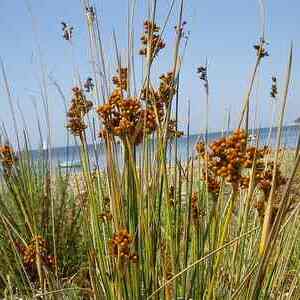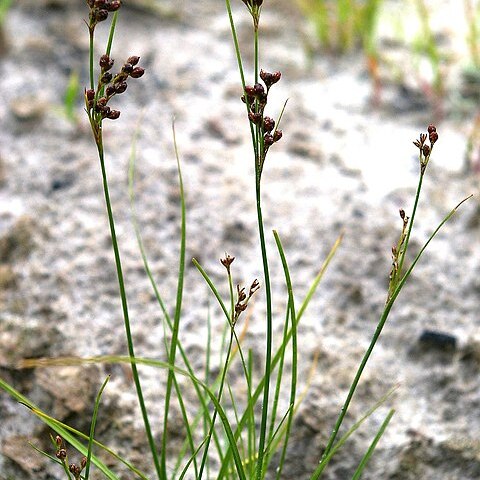Herbs perennial or annual. Rhizome shortly or long creeping. Stems often tufted. Leaves either all basal or also cauline; leaf sheath open on 1 side, apex often auriculate; leaf blade grasslike, terete, or scalelike. Inflorescences terminal, or pseudolateral when basal involucral bract seemingly a continuation of stem, usually many flowered; ultimate divisions dense heads, lax cymes, or 1-flowered. Bracteoles present or absent. Perianth segments 6, in 2 whorls, papery to hyaline. Stamens 3 or 6, attached to base of perianth segments; filaments filiform; anthers oblong or linear. Ovary 1-or 3-loculed; placentas 3, parietal, sometimes inconspicuously prominent but more frequently protruding and sometimes connate at middle; ovules numerous per locule. Style 1; stigmas twisted. Capsule 3-valved; valves usually bearing placentas at middle. Seeds ovoid or oblong, minute, sometimes appendaged; appendage caudate.
Annual or perennial herbs, tufted or rhizomatous, glabrous. Leaves flat and grass-like, or tubular or laterally compressed with internal septa, or channelled, or terete and stem-like, or reduced to basal sheaths. Inflorescence a many-flowered cyme, much-branched or condensed to a compact head, or flowers rarely few or solitary. Flowers usually hermaphrodite, sessile or pedicellate. Tepals 6, rarely 4, lanceolate, the outer usually longer, slightly more rigid with narrow membranous margin, inner with broader membranous margin. Stamens 6, 3, or variable 3-6. Ovary unilocular, or triseptate, or trilocular. Seeds numerous, often tailed at one or both ends. A cosmopolitan genus of c. 300 spp. Native spp. 16, adventive 31.
Tep narrow, lance-subulate to lance-ovate, dry, often firm and even sharp; stamens 6 or 3, opposite the sep when only 3; ovary and fr trilocular, subtrilocular (with incomplete partitions) or unilocular; seeds several to usually numerous (in any case more than 3), commonly ellipsoid or fusiform and minutely apiculate, sometimes with each end prolonged into a slender tail that may be longer than the body; smooth (1 of our spp. scabrous) herbs with usually simple stems and a few flat or terete, basal or cauline lvs, sometimes with bladeless sheaths only, and with a terminal, compact to loosely branched cyme of few–many fls, these solitary, paired, or often in glomerules; lf-sheaths open. 200, cosmop.
Annual or perennial glabrous, tufted or rhizomatous herbs. Leaves grass-like and flat or channelled, or cylindric and smooth, sometimes septate, sheathing below, sometimes reduced to cataphylls; sheaths open, rarely closed. Inflorescence compound, panicled, bracteate; bracteoles sometimes present, placed immediately below and clasping the flower. Flowers hermaphrodite. Perianth-segments free, ovate or lanceolate, entire, persistent. Stamens 3 or 6, attached at the base of the segments; filaments filiform or flattened and triangular; anthers linear or oblong. Ovary sessile; style filiform; stigmas covered with elongated, sticky papillae. Capsule 1-or 3-locular, or incompletely 3-septate. Seeds many.
Herbs, perennial or rarely annual, rhizomatous or cespitose. Culms round or flattened in cross section. Cataphylls often present at culm base. Leaves: sheaths open; blade flat, channeled, ensiform or terete, sometimes septate, margins involute. Inflorescences terminal or pseudoaxillary, monochasia or dichasia, usually with monochasial branches, cymes or 1--many heads in racemes or panicles; bracteoles 2 or absent. Flowers: tepals (4--)6 in 2 whorls; stamens (2--)3--6. Capsules 1-locular or 3-locular, septicidal. Seeds many, ellipsoid to ovoid, sometimes tailed.


